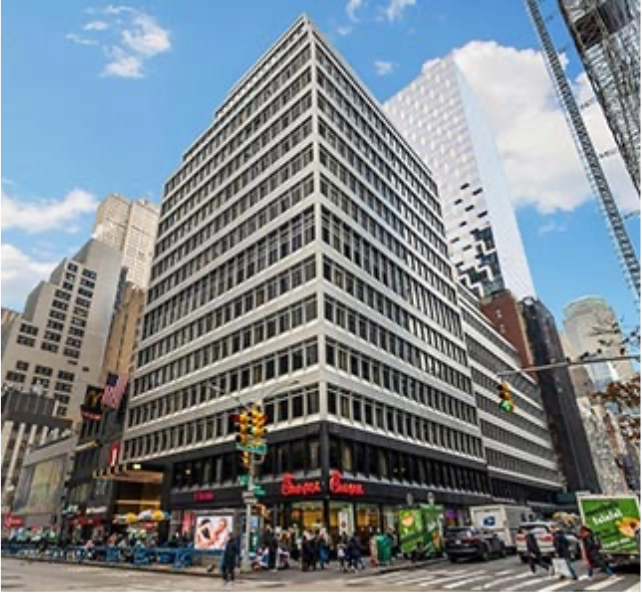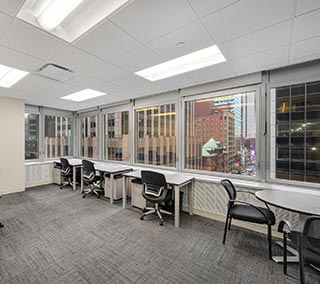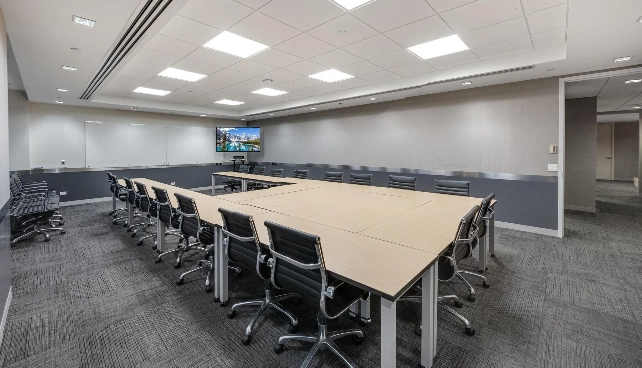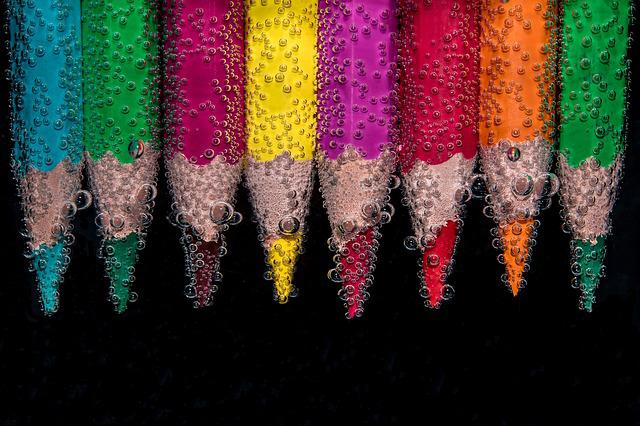Different colors profoundly affect emotions and impact productivity. To improve focus and efficiency, experts suggest using natural-toned colors such as blue or green. Warm colors such as yellow boost energy, promote optimism, and inspire creativity.
Experts in corporate interior design are realizing the huge impact colors in the office have on productivity. Major corporations are now paying close attention to the psychology of color in the workplace to improve employee productivity and their overall well-being. The effort to design an optimal office environment is a well-worth investment that makes a difference in the corporate culture, and ultimately, the company’s profits.
How Productivity is Impacted by Colors in the Office
The University of Texas has conducted a groundbreaking research study which found that colors elicit various reactions in the brain and can impact employees’ productivity and mood.
The study suggests that beige, white, and gray are bland colors that induce emotions related to depression and sadness. This is especially the case for women because they are more receptive to bright colors in the environment. In contrast, men were found to be more sensitive to colors like orange and purple in the office, which makes them feel depressed and gloomy.
Other scientific research studies found that colors do more than just change our moods. In fact, they are also a big factor in our productivity. Experts suggest using a vibrant combination of colors in the office to boost creativity and energy. Bright stimulating colors with inviting hues create a workplace where people feel energetic and productive.
Choose Blue to Increase Productivity and Create a Sense of Calmness
The color blue has been known for its calming effect. The color of the sea and sky are related to feelings of well-being. Blue slows breathing and decreases blood pressure. Researchers found that in addition to creating a relaxing mood, the color blue also stimulates the mind and promotes creativity. This calming and creative effect makes employees more productive.
The study conducted by the University of Texas concluded that an environment that uses a combination of blue and green hues improves productivity much more than those that used white and red combinations. Blue is certainly preferred in the workplace to increase focus and promote productivity in employees. In addition, blue has been found to promote emotions related to trustworthiness and dependability.
Since blue is well received by both men and women, it is used widely around offices, especially in common spaces such as cafeterias and conference rooms.
Green Creates a Relaxing Atmosphere in the Office
Green is a color highly found in nature and it is the reason why it has a calming effect on humans. Color psychologists suggest that nature-inspired decor makes people feel at ease. Another way to bring more green into an office is by incorporating actual living plants. The bright colors of foliage along with their natural element gives an office a relaxing atmosphere that is conducive to creativity.
For its calming effect, green is often used in break rooms and the front lobby. It is a great color for promoting productivity while creating a sense of well-being. In fact, research shows that the human eye can detect more shades of green compared to other colors. It is likely this is due to green being so prevalent in our natural environment. Green is a great background color for offices to prevent eye fatigue and improve focus.
Yellow Promotes Collaboration and Energizes Employees
Yellow is considered to be one of the most uplifting and energizing colors. It is an inviting hue that comes in various shades that are vibrant and energizing. When we observe natural light from the sun, we can see that it creates various shades of yellow and golden tones. It is an inviting color that increases productivity in the workplace by energizing employees and sparking feelings of collaboration.
To create an open and invigorating space, yellow is used in offices to accent certain places, but not as an overall dominating color. Studies show that yellow makes people more sensitive to sounds, which is why this color should only be used in small doses to accent certain areas around the office. To increase productivity, yellow is used to enhance creativity, collaboration, and brainstorming.
Red Creates Awareness
Red can have both a positive and negative effect on the brain. A study shows that students that were exposed to red before an exam scored lowered test scores. It is a color that can create feelings of alertness, which is why it is used in traffic signals. This can sometimes halt productivity, but at the same time, it can have a stimulating effect on the brain.
In the office, red can be used to draw attention to important details such as important signs and memos. Lighter shades of red such as pink can have a light-hearted effect that makes people feel fun and excited. Darker reds such as burgundy can inspire seriousness and sophistication. Using red in the workplace for specific applications can have a positive impact on productivity depending on how it is used.
Purple Creates a Perception of Quality and Value
Purple is a regal color often used by royalty. It provides feelings of confidence and elegance. In the workplace, purple can increase productivity by boosting cognitive attention and allowing employees to become better thinkers.
Although purple is not commonly used around the office, it is used for packaging and branding. It is a color that gives the perception of luxury and value, which can create an excellent corporate culture.
Orange Increases Productivity and High Activity Levels
Research has found orange to be one of the most effective colors to boost productivity in the office. Orange hues come from a combination of yellow and red, which has an energetic effect. The color creates feelings of enthusiasm, activity, and endurance – all related to high productivity levels.
Although orange can energize an environment, it can also solicit a negative reaction from some people Men tend to be less attracted to orange hues, which means it is best used in offices as an accent color but not a predominant one.
Colors to Motivate and Inspire Employees
Color psychologists explain that the primary colors include yellow, green, blue, and red. Each has a different effect on the brain and body and can be used strategically in office settings to motivate and inspire employees to ultimately increase productivity.
Red for Physical Performance
For jobs that require physical labor, red is a stimulating color that gets employees up and moving. It triggers the “fight or flight” response that can be beneficial for certain settings. However, it must be used with caution because it can also hinder work efforts by creating an overstimulating and stressful environment.
Blue for Intellectual Stimulation
Because blue is a soothing color, it helps keep employees calm and clear-headed. It increases concentration and wakefulness while supporting clear communication. It is no wonder why blue is such a popular color in offices and other workspaces. Offices with blue hues and random splashes of orange provide a good atmosphere for administrative work that requires intense focus.
Yellow Supports Emotions
To bring a radiant and positive vibe to the office, yellow is a great color to keep emotions balanced. It is an uplifting color that boosts confidence and puts employees in a great disposition for productivity. It is considered to be the strongest psychological color to spark creativity and boost energy.
Green Brings Balance
As a harmonizing color, green is widely used in various office settings to bring ease to the workplace. It is also a hue that prevents eye strain and general fatigue. As a primary color, it provides feelings of calmness and reassurance. In the office, green is a great color for preventing employees from becoming overwhelmed by daily tasks and deadlines.
Best Colors to Increase Productivity in the Office
Choosing the right color scheme is part of the array of methods utilized by corporate designers to help companies keep their employees productive. Although the color scheme may seem like a minor part of an organization’s business strategy, it does have a big impact on its overall success.
It is important to consider the nature of the business before choosing a color scheme for the office. Maximum productivity is achieved by choosing the right color combinations carefully. Companies should take into account the brand and corporate culture they want to impart to their employees. Providing a sense of continuity and belonging plays a major role in employee performance.
The following colors are sure to help an office become more productive.
Green
As found in nature, green brings a sense of reassurance and balance to the workplace. It can help keep stress managed thus increasing productivity. Green keeps the office environment calm while creating a space easy for the eyes.
Blue
Creative employees contribute a great deal to maximum productivity. As a color that promotes relaxation and ease, blue brings calm and stability to the workplace. It is a mind-stimulating color that makes detail-oriented tasks much easier to carry out. Blue is beneficial for offices that are mentally demanding and require high levels of analysis.
Red
Although red must be used carefully, it is an effective color that promotes a sense of urgency. It is appropriate for offices that require high-energy levels from their employees. However, when designing an office, red should not be overdone as it can also create a mental shut-down.
Yellow
To increase feelings of well-being around the office, yellow accents are a great way for companies to boost their employee performance. It is perfect for environments that require high levels of creativity. Productivity can be significantly increased by incorporating yellow into the environment. Employees will be able to be innovative and progressive while feeling energized and happy.
White
When using white, it is better to use an off-white hue that is more welcoming. It gives the space a sense of purity and clarity. The color can serve as a canvas for bright colors to create a clean and inviting atmosphere.
FAQ
What is the most productive color for an office?
Green and blue are very popular colors for office settings. This combination is related to the colors seen in nature, which is where human beings thrive. Studies have shown green and blue hues to have a balancing effect on the brain. They are by far the most popular colors used in offices.
What colors improve productivity?
The most effective colors to improve productivity are blue, green, yellow, and orange. These colors provide a neutral environment while still creating an invigorating effect. Although the nature of the business has to be considered, these colors are universal and fit in almost any setting.
Why is color important in offices?
It is beneficial to incorporate a strategic color scheme in an office because it can stimulate employees in a positive way and increase productivity. The workplace is considered to be a person’s second home where they spend a large portion of the day. Colors that promote a sense of well-being and inspiration can influence the overall success of a business.
How does color affect the mood and productivity of office workers?
Research has proven that various colors have a direct correlation to a person’s mood and productivity. Humans are motivated by environments that create a sense of calmness and that, at the same time, provide a burst of energy. Color psychology is used when designing workspaces to give employees the best chance at peak performance. When an employee feels their best at work, they will be the most motivated and creative for maximum productivity.
Corporate Suites offers furnished offices spaces, virtual offices & conference rooms in several prestigious locations across New York City and Philadelphia.






